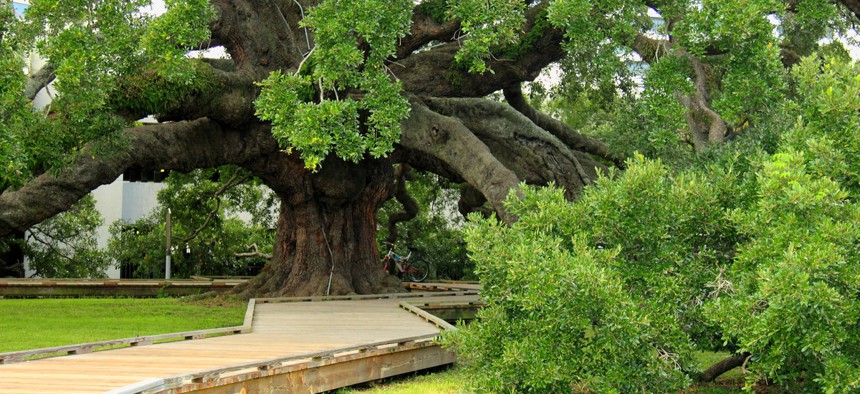The Inequality of Parks and Green Space

Live oak in Jacksonville, Florida park. Faina Gurevich/Shutterstock
New research finds that income, education, and race are correlated with access to green space across and within U.S. metro areas. But some cities are more equitable than others.
America has grown increasingly unequal, with deepening fissures across and within cities by income, education, and race. And those divides are reflected in our access to parks and green space.
That’s the big takeaway of a study conducted by a team of researchers at the University of British Columbia and published earlier this year in the journal Landscape and Urban Planning. The study takes a deep dive into how access to parks and green space varies by class, education, race, and other key variables.
The researchers examine 10 U.S. metro areas: New York, Los Angeles, Chicago, Houston, Seattle, Phoenix, Indianapolis, Jacksonville, Portland, and St. Louis. (These 10 metros were chosen to reflect a range of sizes, densities, types of green space and vegetation, and region of the country.) And they zero in on three major types of green space: green areas (or mixed vegetation), trees (or woody vegetation), and parks.
They use state-of-the-art spatial analytic techniques to carefully isolate key variables while controlling for various factors. The study analyzes green space at the census block and census tract levels, using images of urban vegetation cover available from the satellite images of the U.S. National Agriculture Imagery Program (NAIP), and of parks using GIS information from Esri’s USA Parks map. It compares the distribution of green space to characteristics such as income, education, race, age, and density, based on data from the Census’s American Community Survey.
What it finds is that access to green space reflects broader class and racial divides. The biggest lines of cleavage are income and higher education (which the study measures as the share of college graduates), both of which are positively and significantly associated with access to green space.
Conversely, the share of adults who did not graduate from high school is negatively associated with access to green space. This class divide is more salient for access to trees and green space (wooded and mixed vegetation) that it is for parks. This is likely because more affluent people can purchase access to lots on, or adjacent to, such green space. That said, education and income also play a role in access to parks, albeit less so than for trees and green space.
Race is a factor, too, though not quite as significant as income and education. Shares of Latino and African-American residents are negatively associated with access to green space, with the correlations being stronger for Latinos. Meanwhile, the share of white residents is positively associated with access to green space.
Density plays a curious role. It is positively associated with parks, and negatively associated with both trees and green space (wooded and mixed vegetation). This may simply be because parks tend to be built in denser areas with less private green space, while wooded and mixed vegetation is much more common and accessible in outlying suburban areas.
Interestingly, two metros—Jacksonville and St. Louis—are outliers on some of these trends. In both cities, less educated and Latino residents had better access to trees or green areas.
The study authors also find that the underlying geography of green space varies widely across metros. The spread of green space or mixed vegetation is “particularly wide” in New York, and “particularly narrow” in Los Angeles and Phoenix. Similarly, the spread of tree canopy is especially wide in New York and Chicago, and especially narrow in Los Angeles, Jacksonville, and Phoenix. For park areas, the spread is wide in Chicago and Seattle, and narrow in Houston and Jacksonville. The spread of parks is the most uneven of all forms of green space, with relatively few residents across all the metros in the study having high levels of park access.
Ultimately, access to green space hews closely to America’s long-standing cleavages of class and education. In the words of the paper, “residents with higher levels of education and higher incomes were more likely to have more access to both mixed and woody urban vegetation, and racialized residents were less likely to have access to mixed and woody vegetation in large, dense urban areas.”
This is deeply disturbing, because parks and green space are not just nice to look at: They influence health and well-being. A large body of research shows that green space tempers climate extremes and mitigates the urban heat-island effect, and access to it improves physical and mental health by providing more spaces to walk, relax, and play. It’s important for everyone in a city to have access to those benefits, not just the affluent and highly educated.
CityLab editorial fellow Nicole Javorsky contributed research and editorial assistance to this article.
Richard Florida is a co-founder and editor at large of CityLab, which originally published this article.
NEXT STORY: As Home-Cooked Cottage-Food Industry Grows, States Work to Keep Up





